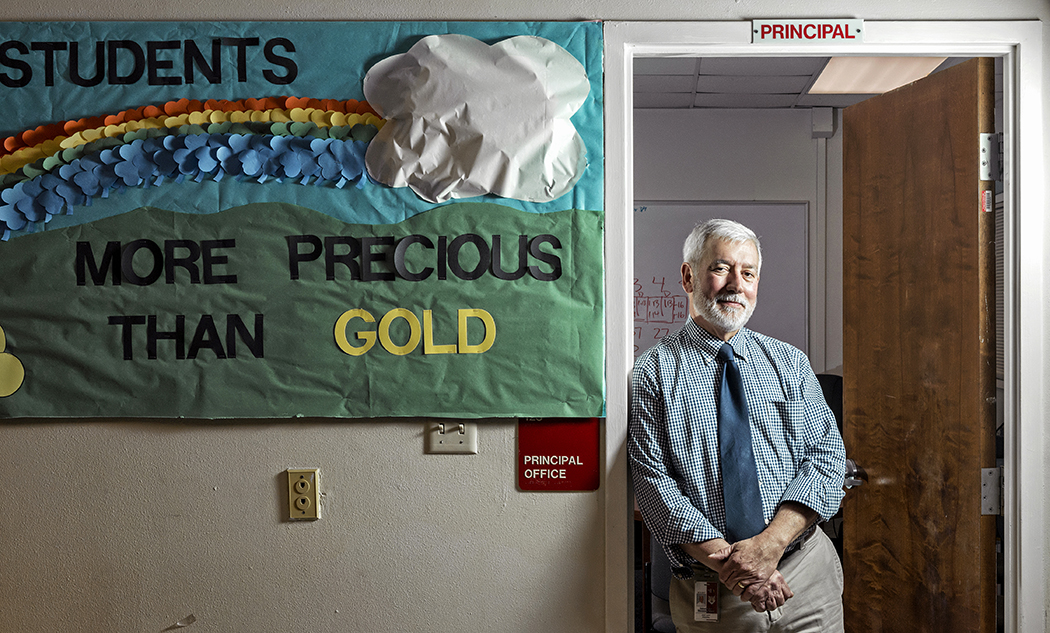
New Robert E. Lee Elementary Principal Bert Hart makes a point of keeping his office door open. (Photo by Danny Fulgencio)
A new principal with a long history in East Dallas wants this historic neighborhood school to grow into its potential
Can I tell you about the Fibonacci sequence?” asked a petite 9-year-old at Robert E. Lee Elementary, who held a flower in her hands. She proceeded to count its petals by layer, demonstrating the mathematical order present in nature.
Her father, Luke Rice, stood nearby, helping another group of students look through microscopes. “She loves the Fibonacci sequence,” said the biophysicist. All around them in Lee’s gymnasium were experiments engaging students and their parents — making slime, churning butter, catapulting popsicle sticks.
It was International Baccalaureate (IB) science showcase night at Lee, a chance for families to see the types of work their children are doing in classrooms. The event was right up the alley of Rice and his wife, biochemist Jen Kohler, who both have labs at UT Southwestern. Rice and Kohler live in Vickery Place, and their choice to send their third-grade daughter to Lee still is somewhat of a rarity for homeowners within Lee’s boundaries.
But perhaps not for much longer.
Lee, situated near Lower Greenville at Matilda and Vanderbilt, is a neighborhood school that more neighbors opt out of than into. Only 217 students zoned to Lee attend the school; another 53 transfer to other Dallas ISD schools or charter schools, and a whopping 526 students opt for private or home school.
“There was some loss of faith in the school by the parents. Once you lose that, it is hard to get it back,” says Principal Bert Hart, who took the helm of Lee last summer. “It happened over a period of years, not just one year. People became disillusioned and left.”
Hart has a long history at schools in our neighborhood, dating back to the ’90s when he began teaching sixth-grade at nearby Stonewall Jackson Elementary. He returned to Stonewall as assistant principal in 2004, right after its parents successfully fought a boundary change that would have zoned more families from overcrowded Stonewall to underutilized Lee.
“I’ve been watching Lee for a long time,” Hart says. “I kept watching the school get smaller and smaller, and I thought, ‘Well, the school can be much bigger than that.’ ”
After two stints as Stonewall’s assistant principal, Hart moved to Lakewood last year and went from assistant principal to interim principal mid-year after Principal Toni Goodman assumed a DISD central office position. Many Lakewood parents campaigned for Hart to be the school’s permanent leader, but Tracie Fraley, who oversaw both Lakewood and Lee as the Woodrow Wilson High School feeder pattern’s executive director, asked Hart to consider interviewing at Lee, which also was without a leader after Principal Bridget Ransom moved to a different DISD school.
Soon after he was hired, Hart began making small but significant changes to mend fences — literally. Parents were heartened over the summer when they saw Hart on the campus grounds overseeing the replacement of the school’s leaning chain-link fence with an upright wrought-iron version, a beautification project funded by the school’s Project Refresh Campaign.
Hart began the school year by opening a door, both literally and metaphorically. The door between his office and the main office stayed closed in prior administrations, but unless he’s having a private conversation that door now remains open.
“I want people to realize they can come in and ask a question,” Hart says. “When someone asks a question or wants to learn, it drops the barrier between the principal and teachers or parents.”

Robert E. Lee Elementary expects to be fully authorized as an International Baccaulaureate (IB) campus this spring. (Photo by Danny Fulgencio)
Hart knows that rebuilding trust is just as crucial as the many academic advantages Lee offers. The school expects to be a fully authorized International Baccalaureate campus this spring. Native English and Spanish speakers who enrolled in Lee’s dual-language immersion program as kindergartners are now in third-grade, and a new crop of kindergartners start each year. Lee even has bilingual pre-K classrooms open to tuition-paying parents. And starting next year, all of its students will learn conversational Spanish as part of the IB curriculum.
Lee parent and PTA board member Jenn Dawkins describes the school as “coming out from under the shadow of previous administrations’ legacy of not encouraging parent and community involvement.”
“This has been a hard legacy to outgrow. A school easily can get labeled, and those perceptions die hard,” she says. “It’s been a challenge to build up any longstanding traditions like other neighborhood schools in our area. That process takes time and, thankfully, we believe the foundation is set for years to come.”
Lee’s campus could educate roughly 600 students, but it’s only half full. When Hart interviewed, he told parents, “My goal is not to have Robert E. Lee be a school in the neighborhood but to be the neighborhood school.” Hart would like to see Lee grow to more than 500 students — “to get to 600 would be great,” he says — but he knows that growth is dependent on pulling in students at pre-K or kindergarten.
A new early childhood PTA, deftly named “Pre-Lee,” should help. It brings together parents of infants to 5-year-olds living within Lee’s boundaries. Mothers on the board refer to their children as “future Cougars,” Lee’s mascot.
“It’s amazing how hungry people are to know their neighbors, to stay where they are,” Pre-Lee board member Jami Kalmbach said at a Vickery Place Neighborhood Associaition gathering last August where Hart was introduced. “If you like living where you live, it’s OK — you can stay. We’re trying to build a community school.”
Hart has attended two of Pre-Lee’s social gatherings this year, and with his history in the neighborhood, he has seen some familiar faces.
“At the Pre-Lee meeting in November, I was talking to one dad and he said, ‘Oh by the way, you were my wife’s sixth-grade teacher.’ I looked and there she was, pregnant,” Hart says. “I keep running into people that, over the years, I’ve either known them, taught them, or known their parents. There are two children here [at Lee] whose parents I taught.”
He plans to stick around long enough to see children of his former students make it through Lee. Hart says people not just in the neighborhood but also around Dallas are starting to take notice — “there is a buzz out there that we’re up and coming and going to be one of the top elementary schools in the district.”
His ultimate goal is to make Lee a Blue Ribbon school, a U.S. Department of Education distinction that Stonewall received in 1999 when he taught there. Lakewood received the honor in 2008 and Hexter Elementary in 2009. Bonham Elementary on Henderson Avenue, whose students were folded into Lee after DISD closed the school in 2012, received the honor in 2010. Hart is hopeful that Lee will be East Dallas’ fifth Blue Ribbon school.
“If you look at the state accountability, it’s confusing, it really is. It’s hard for the layperson to follow exactly what all that means,” Hart says. “But once you get a Blue Ribbon, that’s something people can relate to.
“I’ll know when we get there, we’re where we need to be.”





